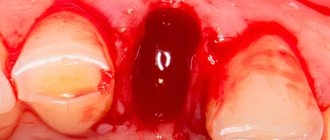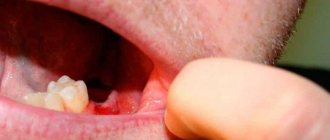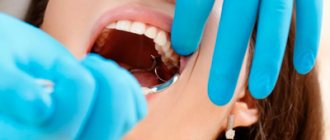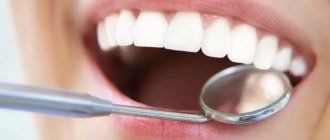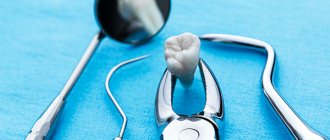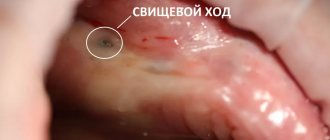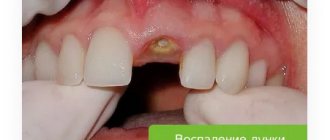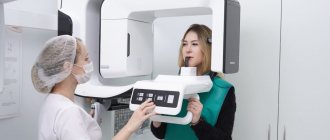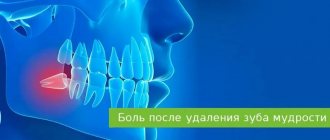Symptoms Causes Consequences Alveolitis Diagnosis and treatment Features of wisdom teeth Treatment at home Prevention
Tooth extraction is one of the most popular and simplest operations in medicine. Usually it passes without complications, but due to a number of general or subjective reasons, deviations may occur. One such postoperative complication is dry socket.
The fact is that after extraction of a tooth, a cavity forms in its place, which, in a positive scenario, is filled with a blood clot. It prevents the penetration of microbes into an open wound and promotes its speedy healing. A dry socket after tooth extraction is the absence of that same blood clot in the socket. This can happen for two reasons:
- Loss or resorption.
- Severe bleeding that prevented a clot from forming.
Whatever the reason, the healing process can take weeks and be accompanied by serious discomfort, which is not always possible to eliminate on your own.
Symptoms
Dry socket syndrome is very painful. It is quite easy to identify if the following symptoms appear within 2-3 days after tooth extraction:
- inflammation of the gums, accompanied by severe pain;
- pain in the cervical region and ears;
- the appearance of bad breath;
- taste of pus in the mouth;
- partial hearing loss;
- general malaise
Visually, a dry socket is an empty depression at the site of tooth growth, first exposing the jawbone, and then turning into a reddened, purulent wound.
Normally, the socket is a cavity that, after tooth extraction, is filled with ichor. Over the next three days, the clot thickens, and light fibrin stripes appear on it - the beginning of the formation of new gum tissue. There may be slight soreness at the wound site. From 4 to 7 days, swelling gradually subsides, and the gums acquire their usual pink color. There is no pain.
Tips for caring for a healing socket
The success of wound healing depends on two people: the doctor and the patient. If the doctor has already done everything in his power, it is up to the patient. The latter needs to be taken into account and carefully follow the recommendations and prescriptions. These may include the following:
- Leave in place and do not remove the embedded turunda (bandage). It protects against infection and promotes healing, and is often covered with medication. Usually the turunda is removed after 30 minutes, but in some cases (with complex wisdom tooth removal) it will have to be kept for 5-15 days.
- Follow a rinsing schedule. A specialist can prohibit them or recommend them. This point is very important. The best option is to take the medicinal solution into your mouth and simply tilt your head towards the healing hole.
After a tooth is removed, a blood clot should form in the wound. You shouldn’t disturb him for no reason, no matter how much you want to. It protects the wound from infections. Therefore, you do not need to rinse your mouth more often than the specialist advised, or do it too intensively. Water can wash out the clot, and then healing will be delayed.
If bleeding occurs, you can take clean gauze, roll it up in several layers, place it on the hole, bite and hold for up to 45 minutes. If bleeding continues for a long time, you will have to go to the doctor again.
After the anesthesia wears off, pain may occur. There is no point in enduring pain. It is worth using the painkiller recommended by the doctor. Also, do not ignore the recommendation to take medications. The experience of a specialist will tell you what a particular patient needs.
In a normal case, the hole heals and stops bothering you after about a week. If there are complications, the process takes longer and causes inconvenience. If the drug course is completed, no complications are observed and the hole has healed, you can simply stop thinking about it - it does not need attention. The only point that concerns the gums in general is that it is better to handle toothpicks more carefully and not to get into a recently healed area.
Causes of dry socket
There are several causes of dry socket. Some of them can be prevented by following simple recommendations regarding personal hygiene and caution. Causes:
- smoking. In this case, there is a decrease in pressure in the oral cavity, which can lead to the loss of the formed clot;
- neglect of oral hygiene;
- low blood clotting;
- taking oral contraceptives;
- mechanical damage to the hole itself or the tissues around it.
In addition to the above reasons, a dry socket can appear as a result of an incorrectly performed tooth extraction procedure. During a complex extraction, when the tooth had to be removed from the gums in parts. All rules recommended before and after extraction must be followed.
Causes of swelling after removal
Swelling of the mucous membrane in the area of removal in the gum area, as well as swelling of the cheeks, are also considered normal after wisdom tooth extraction. This is explained by tissue injury and the body’s natural reaction to the procedure. Normally, swelling increases the next day after visiting a dental surgeon, but then, if all recommendations are followed, it should subside.
If the swelling continues to increase, you should consult a doctor. The same applies to situations where, in addition to tissue swelling, there is increased pain, discharge from the socket, and increased body temperature. The listed signs indicate inflammation, which requires initiation of treatment.
The signs will be especially pronounced if there was already purulent inflammation at the time of visiting the dentist. In this case, even a correctly performed procedure, creating an outflow of inflammatory exudate, does not exclude an increase in tissue edema. When removing the upper tooth, swelling may spread to the orbital area. During surgery on the third molar of the mandible, swelling may extend to the neck and ear area. If after a day the symptom becomes less pronounced, we can assume that there are no complications.
In addition to increased swelling and pain, the following signs will be an indication for an emergency visit to the dentist:
- Discharge of pus from the socket.
- Bleeding.
- Pain when swallowing.
- Pain when trying to open your mouth.
- Swelling of the face, accompanied by redness of the skin.
It is unlikely that tissue swelling will be completely avoided, but the risk of complications can be reduced. It is enough to follow the doctor’s instructions, take prescribed medications and monitor oral hygiene.
Consequences
If during the first two days after tooth extraction pain appears, swelling does not subside and the temperature rises, then most likely these are signs of inflammation. In this case, you should immediately consult a doctor, as dry socket syndrome can lead to serious complications. Such as:
- flux.
It begins to form when an infection gets into the hole. Characterized by severe swelling and pain. Requires immediate specialist intervention. - alveolitis
This is a deeper penetration of the infection - deep into the gums. Bacteria spread quickly and, if this process is not stopped in time, there is a risk of tissue necrosis. In this case, the losses can be very serious.
Attention!
The consequences of untimely or incorrect treatment can be irreversible. Do not neglect your doctor's advice. A wound on the mucous membrane is always a vulnerable area, subject to attack by bacteria and their rapid spread.
What to do if a tooth is removed
Stop the bleeding.
If you have had a tooth removed, your doctor will tell you in detail what to do in the first hours after the operation. For some time after the procedure, blood may flow from the hole. To stop bleeding, you need to place a cotton swab on the empty alveolus, bite it firmly and hold it there for 45 minutes. If bleeding continues, you should contact your dentist to prescribe a course of treatment after tooth extraction.
Do not injure the blood clot.
The blood clot that forms at the site where the tooth was is important for healing, so care must be taken to avoid traumatizing it.
The clot can be damaged by hard food, a toothbrush or a toothpick. Brushing your teeth is a must, but it should be done carefully. If oral hygiene is not maintained, the infection accumulates in the oral cavity and can cause pain and inflammation of the alveoli, which requires the doctor to prescribe treatment after tooth extraction.
Do not eat hot or cold food.
During the day you should not take very cold or hot food or drinks. Temperature changes lead to narrowing and dilation of blood vessels, which can cause bleeding from the socket. For the same reason, doctors do not recommend going to the bathhouse, taking a hot bath or shower. It is also not advisable to drink alcoholic beverages on the first day after a dental procedure.
Up to contents
Forms of alveolitis
Depending on the course of the complication, three stages are distinguished:
- Serous.
It makes itself felt
2-3 days
after tooth extraction. At this stage, pain occurs when eating, headache. Lymph nodes increase in size. - Purulent.
This is the next form that occurs after the serous one, if timely treatment is not carried out. Diagnosed a week after the tooth was removed. The pain becomes unbearable and is also felt in the head or ear. The hole becomes covered with a purulent, dirty yellow coating. There is an unpleasant odor from the mouth. Swelling and lymph nodes enlarge and become painful. Opening your mouth and eating food is extremely difficult due to pain. - Hypertrophic.
At this stage, it seems that the symptoms are subside: the condition is normalized, the temperature decreases. However, atrophied tissue grows, and when pressure is applied, pus is released from the inflamed wound.
If you notice any of the above symptoms, you should not self-medicate, but rather consult a dentist.
Antibiotics after tooth extraction –
Antibiotics after tooth extraction should be prescribed by a dental surgeon and not taken independently. An antibiotic for tooth extraction is always prescribed in situations where -
- the tooth was removed due to inflammation,
- it was difficult to remove
- there is a risk of complications.
Amoxiclav after tooth extraction is one of the most effective and popular drugs among dental surgeons, because it has affinity for bone tissue. Adults need Amoxiclav 625 mg (each tablet contains amoxicillin 500 mg and clavulanic acid 125 mg). The drug is taken 2 times a day for 5 to 7 days. But we DO NOT RECOMMEND taking this drug, because... immediately in 10-25% of patients - it causes antibiotic-associated diarrhea. Follow the link above to read a review article on the use of antibiotics in dentistry.
Reduce the risk of developing diarrhea when taking Amoxiclav or Augmentin - if you combine it with taking Metronidazole (Trichopol). This combination is not only safer in terms of diarrhea, but also significantly enhances the antibacterial effect. The antibiotic Metronidazole is especially effective against anaerobic bacteria and protozoa, which are especially numerous in chronic purulent inflammation (for example, in the area of the roots of teeth), while Amoxiclav and Augmentin do not have a clinically significant effect on protozoa.
But the risk of diarrhea will be lowest when using fluoroquinolone antibiotics. Among the antibiotics of this group, we especially highlight the combination drugs “Tsiprolet-A” or “Tsifran-ST”, which in addition to 500 mg of ciprofloxacin also contain 600 mg of tinidazole. Fluoroquinolones themselves cause diarrhea in only 1-2% of cases, but the above drugs also contain tinidazole (an analogue of metronidazole). Tinidazole also has antiprotozoal activity, i.e. it will be effective against anaerobic microorganisms, including Clostridium difficile and Clostridium perfringens, which are responsible for the development of diarrhea while taking antibiotics,
Important: because These antibiotics are not cheap - as an alternative, we will also indicate such a drug as the usual “Tsiprolet”, which contains only ciprofloxacin (without tinidazole). This antibiotic costs only 90 rubles per pack, but it is slightly less effective for purulent inflammation than the antibiotics Tsiprolet-A or Tsifran-ST.
Another antibiotic that everyone knows about is Lincomycin 0.25 (taken 2 capsules 3 times a day, usually 5 days). This is an inexpensive, moderately effective drug, but it kills all life in the intestines due to poor bioavailability (only 30% of the drug is absorbed from the intestines if taken on an empty stomach, and only 6% when taken with food). Therefore, it may turn out that, having bought a cheap antibiotic, you will then have to “expensively” restore the intestinal microflora.
How to reduce the risk of diarrhea after taking antibiotics -
Of course, parallel intake of probiotics (i.e., drugs that contain bacteria beneficial to our intestines) can help you with this. There are a large number of probiotics, but the best of them are Linex and Bifiform. Keep in mind that it is better to choose multicomponent preparations that contain several types of beneficial bacteria. Probiotics may contain lactobacilli, bifidobacteria, enterococci, and their combinations.
Probiotic Bifiform (30 capsules) –
Diagnosis and treatment methods
Diagnostics at a dentist's appointment will help confirm the symptoms of a dry socket. After an examination, the doctor will prescribe treatment. As a rule, it depends on the stage of inflammation. In the case of a mild form, drug treatment with antiseptics and anti-inflammatory drugs is possible. At the middle stage, you will need antibacterial therapy, as well as cleaning the hole from pus and filling it with an anti-inflammatory drug. All actions are performed under anesthesia. If necessary, antibiotics are prescribed.
At the third stage, the most advanced stage, the patient may need hospitalization and even surgical intervention. With proper care and no complications, the hole heals within seven days. And a month later there is no trace left of her.
Features of wisdom tooth removal
Dry socket after wisdom tooth removal is not uncommon. This syndrome occurs especially often in the lower jaw due to the fact that as a result of swallowing and opening the mouth, the muscles tense, aggravating the appearance of a dry socket and, as a result, alveolitis. Dry socket occurs in approximately 50% of cases
. Due to the anatomical features of the jaw, the blood clot often falls out.
When extracting a wisdom tooth, you must carefully observe precautions and resort to this procedure only in cases of extreme necessity. After all, the inaccessibility of the place complicates treatment.
Oral hygiene
It is not carried out on the first day to exclude infection and accidental injury. Chlorhexidine can be used almost immediately after tooth extraction, as it does not cause side effects; the main thing is to rinse carefully and according to the instructions. Further hygienic cleaning can be performed once a day with a soft brush, carefully avoiding the surgical area.
Floss is also used to remove food debris from between teeth and a warm saline solution is used to rinse the mouth after each meal. Do not forget about cleansing your tongue, as plaque also accumulates on it, in which bacteria actively multiply.
Removal of sutures after tooth extraction occurs on the 7th - 10th day. By this time, the wounds have already healed and restrictions on hygiene procedures are lifted. Cleaning is carried out twice: in the morning and in the evening.
Treatment of dry tooth socket at home
If the pain from dry socket inflammation is too severe, you can take painkillers. In the first two days, apply cold compresses to the inflamed side at intervals of 20 minutes, then change to warm ones.
Drink more fluids, especially water. It removes harmful substances from the body. Avoid alcohol.
Rinse your mouth with a salt water solution. This clears the wound of dead cells and relieves inflammation. But you should not apply pressure in the area of the hole - you can provoke the displacement of the blood clot. You should rinse your mouth after every meal and before going to bed.
You can also apply a drop of clove oil to the wound to relieve pain. Rinsing with sage and chamomile flowers, a decoction of burdock leaves and aspen bark, and anise infusion will also have a positive effect.
If after all the treatments the pain has not subsided, the swelling has not subsided, and your health has only worsened, then you should urgently consult a doctor. There is a high probability that the process of rotting has begun.
In the dental office, the doctor, under anesthesia, will clean the hole or prepare the gums - depending on the degree of neglect of the case. Fill it with antiseptic gel.
Prevention
Preventing dry socket is always easier and cheaper than treating dry socket. To do this, you need to follow a number of preventive measures. Namely:
- If possible, limit physical activity for several days after tooth extraction;
- do not touch the removal site with your hands or tongue;
- do not chew on this side;
- eliminate the use of tobacco and alcohol;
- do not eat too hot, cold or spicy foods;
- It is advisable to grind food into puree.
Expert of the article Bolshakova Evgenia Vladimirovna Dentist-hygienist
More than 11 years of experience
Treatment in the clinic
The optimal solution for treating a diagnosis of dry socket or alveolitis is a visit to the dentist. It is better to go to the same doctor who performed the tooth extraction, since he already knows the course of the operation, did the diagnostics and remembers the characteristics of your body.
Whatever clinic you choose to contact, study its website, the doctors who work there and reviews.
At the RUTT dental center we use the latest equipment and advanced materials. The experience of our doctors is confirmed by numerous diplomas, certificates and awards. You can be sure that you will be in the hands of a reliable specialist.

